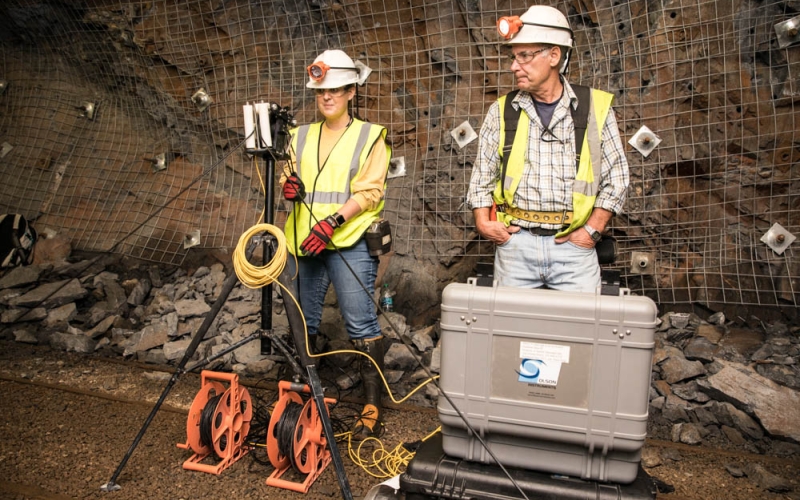
Research scientists from Berkeley and Sandia National Labs and the South Dakota School of Mines and Technology led a group of DOE leaders on a tour of SURF, an underground observatory for studying geothermal energy extraction strategies. Pictured from left to right: Jaret Heise, Doug Blankenship, Albert Eiffes, Mike Headley, David Vardiman, Bill Roggenthen, Tim Unruh, Tim Kneafsey, Sue Hamm and Lauren Boyd.
Click here for the original article from Lawrence Berkeley Lab.
In February, Berkeley Earth and Environmental Science Area (EESA) Staff Scientist Tim Kneafsey helped escort leadership from the Department of Energy (DOE) Office of Energy Efficiency and Renewable Energy on a journey 4,850 feet below the ground. They toured Sanford Underground Research Facility (SURF), an old South Dakota gold mine turned testing ground for studying how the process of extracting heat from rocks deep in the Earth’s subsurface can be enhanced to open up access to clean energy.
The United States derives 80 percent of its energy from the Earth’s subsurface. With $9 million in DOE funding each year over three years, Berkeley National Lab leads a collaboration of seven other national labs and six universities exploring the potential to improve enhanced geothermal systems technologies. The Enhanced Geothermal Systems (EGS) Collab Project team hopes to help remove barriers that stand in the way of commercializing enhanced geothermal systems.
Field experiments conducted at SURF by the collaboration are focused on improving the understanding and modeling of rock fractures in these geothermal environments. With better information about how rocks behave in the Earth’s subsurface, EGS technologies stand a better chance of fulfilling their potential to provide enough energy to power 100 million American homes.
Geothermal energy requires hot rock, fluids, and permeability—or the ability for fluids to flow through rock. In enhanced geothermal systems, heat acquired from water circulating in rock fractures deep in the subsurface is extracted and converted to electricity. Enhanced geothermal systems rely on creating permeability, adding supplemental fluids, or both, according to Kneafsey, who says, “Enhanced geothermal systems enable access to far more geothermal energy than there would be otherwise.”
With better information about how rocks behave in the Earth’s subsurface, EGS technologies stand a better chance of fulfilling their potential to provide enough energy to power 100 million American homes.
At SURF, the visiting DOE leadership toured the facility and laboratories and learned about the work underway there through presentations about SURF and the EGS Collab Project. Kneafsey and his co-principal investigator Doug Blankenship of Sandia National Laboratories and Professor Bill Roggenthen of South Dakota School of Mines and Technology described part of what it takes to add permeability to rock a mile or more underground.
Currently in year one of a three-year project, the study team is tasked with improving modeling tools by providing data from carefully stimulating, monitoring, and characterizing flow paths through subsurface rock to support the development of improved strategies for extracting heat from the Earth’s subsurface. Their work to date has focused on designing and building the field test site at SURF and instrumenting test beds there with tools needed to monitor and characterize their hydraulic fracturing and flow experiments. They needed a facility adequate in size and structure to conduct experiments that involve injecting small amounts of water into the rock at very high pressures until the rock fractures.
“We have been operating from a tunnel to drill eight boreholes into the rock. Each is about 60 meters long. From here, we will be injecting fluid into one of the holes and stimulating — or breaking — the rock,” says Kneafsey. The other holes will be used for monitoring or producing the injected water.
The boreholes for monitoring will include instruments to quantify microseismic activity, electrical resistivity tomography, temperature, and strain — or how pieces of rock move in response to stimulation. Using a tool developed at Berkeley Lab called SIMFIP (Step-Rate Injection Method for Fracture In-Situ Properties), they can examine what happens to the openings of fractures created by stimulation when pressure is applied.
“The tool monitors how two adjacent pieces of rock move in relation to one another. When you stimulate rock, you have to create or open a fracture,” says Kneafsey. “In an ideal world, you would like to shear the rock pieces relative to one another without creating too large a gap between them. The goal is to create just the right amount of space through which water can flow.”
Berkeley Lab scientists working to explore energy technologies underground understand that the Earth’s subsurface will remain part of the country’s energy strategy for decades to come. They are hopeful that by helping identify ways to enhance the permeability of rock via tunnels and caverns, they can ultimately help transform access to clean energy.
